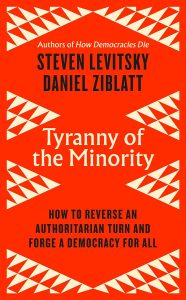In Tyranny of the Minority: How to Reverse an Authoritarian Turn and Forge a Democracy for All, Steven Levitsky and Daniel Ziblatt consider the institutions and practices of counter-majoritarianism in the United States. The book effectively demonstrates that American democracy is under attack, but the authors’ proposals for constitutional amendments to help end that attack are unlikely to be implemented, writes Larry Patriquin.
Tyranny of the Minority: How to Reverse an Authoritarian Turn and Forge a Democracy for All. Steven Levitsky and Daniel Ziblatt. Viking. 2023.
 A spectre is haunting America – the spectre of Donald Trump, the loose cannon who defeated his competitors for the Republican Party nomination in 2016 and then went on to shock the world by winning the presidency. From that point on, almost all Republican politicians offered their support to him, while the few remaining GOP dissidents were effectively silenced. It all ended badly, however, with Trump’s refusal to accept his defeat in November 2020 and the ensuing coup attempt, which he encouraged, in January 2021.
A spectre is haunting America – the spectre of Donald Trump, the loose cannon who defeated his competitors for the Republican Party nomination in 2016 and then went on to shock the world by winning the presidency. From that point on, almost all Republican politicians offered their support to him, while the few remaining GOP dissidents were effectively silenced. It all ended badly, however, with Trump’s refusal to accept his defeat in November 2020 and the ensuing coup attempt, which he encouraged, in January 2021.
As late as the 1960s, the Democrats and Republicans were “big tent” organisations dominated by white Christians. As a result, they had much in common
So, how did we get here? Steven Levitsky and Daniel Ziblatt argue that as late as the 1960s, the Democrats and Republicans were “big tent” organisations dominated by white Christians. As a result, they had much in common, so both were able to vote overwhelmingly in favour of important legislation, including the 1964 Civil Rights Act and the 1965 Voting Rights Act. But shortly thereafter, the Republicans began to pursue a hardcore “white party” strategy as the best way to win elections, drawing southern white voters away from the Democrats. This process solidified by the time of Richard Nixon’s re-election in 1972 and was mostly complete with the GOP’s embrace of burgeoning Christian fundamentalism in the 1970s and 1980s.
The United States is now a country where electoral minorities, rooted in a mostly white, rural-based party, can consistently rule over and dominate a multiracial, highly urbanised society.
Today, however, the Republicans are trying to scupper democracy. They realise they cannot win elections if they play by the rules, because they have for the most part abandoned the vast majority of non-white citizens, in a society that is becoming more diverse with each passing year. This has had profound effects on American governance. Representative democracies are supposed to ensure that majorities can implement their favoured policies and are able to do so relatively easily and peacefully. But the United States is now a country where electoral minorities, rooted in a mostly white, rural-based party, can consistently rule over and dominate a multiracial, highly urbanised society.
This turn toward authoritarianism has unfolded because of the US’s counter-majoritarian institutions and practices.
This turn toward authoritarianism has unfolded because of the US’s counter-majoritarian institutions and practices. These include, among others: (1) a politicised Supreme Court, in which six of its nine justices regularly contribute to rulings that are reactionary and antidemocratic; (2) the apportionment of two senators to each state (the same number, for instance, to Wyoming’s 580,000 residents as to California’s 39 million); (3) a constitution that is almost impossible to amend (aside from a minor amendment in 1992 on Congressional salaries, the last successful amendment was in 1971 – that is, more than 50 years ago – when the voting age was lowered to 18); (4) the Electoral College, which enabled Donald Trump to capture the presidency in 2016 even though he lost the popular vote by 3 million votes; and (5) the Senate filibuster, which requires 60 votes for a bill to proceed to the floor, hence serving as an effective veto of potential legislation by 41 senators.
In sum, “in America majorities do not really rule” (225). In response, Levitsky and Ziblatt make ten general recommendations on how to move forward, including having the government register voters, creating independent redistricting commissions in every state, and abolishing the Senate filibuster. There is a reasonable possibility that most of these reforms could be implemented.
This is not the case, however, for their additional five recommendations, which would necessitate constitutional amendments. They would like to: (1) enshrine the right to vote; (2) abolish the Electoral College; (3) have Senate seats distributed more in line with each state’s population; (4) create term limits for Supreme Court justices; and (5) revise the Constitution’s amendment process by removing the requirement to have three quarters of the states approve each proposed amendment.
They point to the abolition of slavery and the extension of suffrage to women, both of which were forward-looking ideas at one time, but were eventually implemented
Levitsky and Ziblatt anticipate my main objection to their constitutional proposals: that if they “make sense in theory, aren’t they utterly unrealistic in practice?” (236) They argue, though, that while there would be serious obstacles to their passage, these amendments are within the realm of possibility and so should at least be debated. They point to the abolition of slavery and the extension of suffrage to women, both of which were forward-looking ideas at one time, but were eventually implemented, even if they took a century or two to accomplish.
They suggest that the “unrealistic” criticism could come down to the perception that the “reforms we propose might appear radical” (236). They add that the refusal to at least air these reforms is problematic, noting that if “an ambitious idea is ‘unthinkable’,” then “the battle is lost” (238). However, the content of Levitsky and Ziblatt’s proposals is neither ambitious nor radical. As they observe, they are recommending laws and regulations similar to those in place in just about every nation outside the US.
Previous landmark constitutional amendments occurred during and after extended calamities, including the Civil War, World War I, and the massive civil rights movement of the 1960s. I am not sure the successes created in these instances could be replicated today
Still, their proposals are unlikely to pass, at least any time soon. This is because previous landmark constitutional amendments occurred during and after extended calamities, including the Civil War, World War I, and the massive civil rights movement of the 1960s. I am not sure the successes created in these instances could be replicated today, especially given that – as the authors effectively demonstrate over hundreds of pages – the Republican Party and its supporters have detached themselves from democracy, from the law, and even from reality.
The current political climate in the US is much more toxic than it was a half century ago
The current political climate in the US is much more toxic than it was a half century ago, yet throughout the 1970s advocates could not get final approval from enough states to support the Equal Rights Amendment, which passed in Congress in 1972. It would have enabled the following sentence to become part of the Constitution: “Equality of rights under the law shall not be denied or abridged by the United States or by any State on account of sex.” If something so basic, something almost no sentient being would oppose, could not find its way into the Constitution, then none of the authors’ proposed amendments, all of which would significantly reduce the power of Trump-crazed Republicans, seem to have any chance of ratification.
At the time of writing, Donald Trump held a massive lead in polling for the Republican primary – with more support than all other candidates combined – so barring an asteroid hitting the earth, he will be the Republican nominee for president in 2024, and he could very well defeat Joe Biden (the two are currently running neck-and-neck in the polls). If that happens, or if Trump loses and he again cheers on his violent sycophants as they rampage through Washington, the US will not be in a position to enact sensible constitutional amendments, even ones that are relatively uncontroversial – even one which, for instance, would declare that women are equal to men.
- This review first appeared at LSE Review of Books.
- Image Credit: tai11 on Shutterstock.
- Please read our comments policy before commenting.
- Note: This article gives the views of the reviewer, and not the position of USAPP – American Politics and Policy, nor of the London School of Economics.
- Shortened URL for this post: https://bit.ly/47LTkMM






